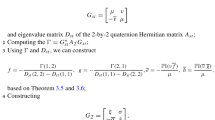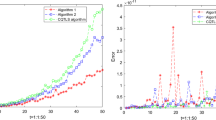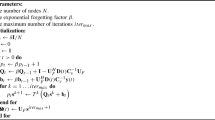Abstract
In this paper, the planar coordinate transformation model in the complex field is constructed. It is more concise than the traditional planar coordinate transformation model in the real field, because it combines the x and y coordinates as a whole. In order to carry out the complex parameter estimation, the paper introduces the complex least squares and the complex Gauss-Jacobi combinatorial algorithm. A simulative numerical case study and an actual one are given to investigate the correctness and efficiency of the presented approaches. The results show that the complex least squares for the complex transformation model obtains the identical estimation as the conventional least squares for the real transformation model, thus it is a reliable least squares for the complex parameter estimation. However, for the case of gross error, it becomes invalid. On the contrary, the complex Gauss-Jacobi combinatorial algorithm is capable of detecting the gross error based on its parameter estimations of numerous combinations. Consequently, it is verified as a good robust estimation by the numerical case study.





Similar content being viewed by others
References
Akyilmaz O (2007) Total least squares solution of coordinate transformation. Surv Rev 39(303):68–80
Awange JL, Grafarend EW (2003) Explicit solution of the overdetermined three-dimensional resection problem. J Geod 76:605–616
Elgot CC (1954) Least squares over the complex field. NAVORD Report 3797, Aeroballistic Research Report No. 250, U.S. Naval Ordance Laboratory, Ehite Oak, Maryland
Ge Y, Yuan Y, Jia N (2013) More efficient methods among commonly used robust estimation methods for GPS coordinate transformation. Surv Rev 45(330):229–234
Gray A, Abbeno E, Salamon S (2006) Modern differential geometry of curves and surfaces with Mathematica. Chapman & Hall/CRC, Boca Raton
Gu X, Kang H, Cao H (2006) The least-square method in complex number domain. Prog Nat Sci 16(3):307–312
Neitzel F (2010) Generalization of total least-squares on example of weighted 2D similarity transformation. J Geod 84(12):751–762. doi:10.1007/s00190-010-0408-0
Paláncz B, Awange JL, Völgyesi L (2013) Pareto optimality solution of the Gauss-Helmert model. Acta Geod Geophys 48:293–304
Proskova J (2012) Discovery of dual quaternions for geodesy. J Geom Graph 16(2):195–209
Shen YZ, Chen Y, Zheng DH (2006) A quaternion-based geodetic datum transformation algorithm. J Geod 80:233–239
Wang S, Zhang D, Sun H (2007) On methods of plane coordinate transformation in GPS-RTK surveying. J Geomat 32(4):17–19
Yao J (2006) Physical significance interpretation of plane coordinate conversion and direct calculation of conversion parameter. Metal Mine (12):43-45+84
Yao Y (2001) A simple and convenient arithmetic for the transformation of plane coordinate system. J Geomat 26(1):1–3
Zeng HE, Yi QL (2011) Quaternion-based iterative solution of three-dimensional coordinate transformation problem. J Comput 6(7):1361–1368
Acknowledgements
The study is supported by National Natural Science Foundation of China (Grant No. 41104009), Open Research Fund Program of the Key Laboratory of Geospace Environment and Geodesy, Ministry of Education, China (Grant No. 11-01-04), and the Open Foundation of the Key Laboratory of Precise Engineering and Industry Surveying, National Administration of Surveying, Mapping and Geoinformation of China (Grant No. PF2011-4). The study is completed in Wuhan University the Key Laboratory of Geospace Environment and Geodesy, Ministry of Education, China. The author is grateful to the support and good working atmosphere provided by his research team in China Three Gorges University.
Author information
Authors and Affiliations
Corresponding author
Rights and permissions
About this article
Cite this article
Zeng, H. Planar coordinate transformation and its parameter estimation in the complex number field. Acta Geod Geophys 49, 79–94 (2014). https://doi.org/10.1007/s40328-014-0040-1
Received:
Accepted:
Published:
Issue Date:
DOI: https://doi.org/10.1007/s40328-014-0040-1




